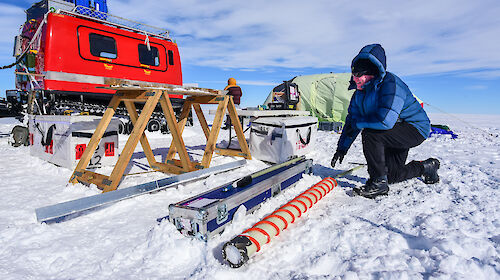French oceanographer Jacques Cousteau famously described the ocean as ‘the silent world’, but according to Australian Antarctic Division underwater acoustician, Dr Brian Miller, he couldn’t have been more wrong.
To demonstrate, Dr Miller has captured the enormous spectrum of sounds in the Southern Ocean to produce a range of visual soundscapes.
“There are so many sounds in the Southern Ocean, including the physical sounds of wind, rain and icebergs, occasional man-made sounds from ships and construction, and copious biological sounds, especially those made by whales, dolphins and seals,” Dr Miller said.
The sounds were recorded over several years using specially designed acoustic instruments, moored to the sea floor at different sites off East Antarctica, for up to one year at a time.
The acoustic moorings assist research into the recovery from whaling of endangered Antarctic blue whales and fin whales. They are also part of the Southern Ocean Hydrophone Network, a network of about 20 listening stations deployed around Antarctica by international collaborators, to passively monitor blue and fin whales.
“Blue and fin whales are rarely seen, but they are very vocal and we can hear them over very large distances. So listening for them is an efficient way to study them and to monitor whether their populations are recovering,” Dr Miller said.
The Australian Antarctic Division has up to three moorings deployed on the shipping routes between Hobart and Australia’s Antarctic stations at any one time, as well as opportunistic locations, including in the Ross Sea and off Heard Island and McDonald Islands.
The instruments, developed by the Australian Antarctic Division’s Science Technical Support group, continuously record sound in the 1 to 6000 Hz bandwidth, enabling them to capture the very low frequency calls of blue whales, as well as fin, minke, humpback and sperm whales, and most seal species.
After a year of recording, each instrument contains some 8760 hours of stored audio.
“After the moorings are recovered, our electronics engineer downloads the data from the 32 SD cards and converts them to audio files,” Dr Miller said.
“It’s so exciting, it’s like Christmas. The first thing I do is generate a graphic to visualise the year of sound. Each coloured vertical slice is the average of about four hours of sound.
“I can see how well the instrument has recorded, if there were any big icebergs or storms, and if we’ve recorded any sounds we’ve never heard before. I can also get an indication of what species were and weren’t present.”
As the years of data accrue, Dr Miller hopes to make comparisons to identify trends in the presence and number of whales, and the sounds they make, within and between sites.
He is currently working on ways to standardise data collected by different acoustic recorders in the hydrophone network, so that circumpolar recordings can be meaningfully compared.
“We hope to be able to count the number of calls and measure the amount of sound energy so we can make robust statistical comparisons between sites or within a site over time,” he said.
“A lot of the questions that we’re trying to answer seem simple, for example: how many whales are there, where are they, when do we see them? These are fundamental questions that you need to be able to answer if you want to have any chance of conserving and managing populations of whales effectively.
“For some species, particularly Antarctic blue whales, fin whales, and sperm whales, these questions would be prohibitively expensive to answer without acoustic monitoring.”





